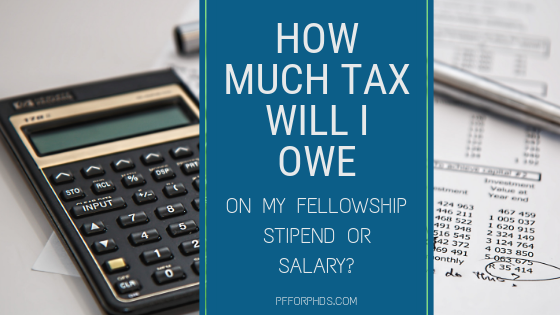If you have recently started receiving a fellowship for your graduate or postdoc stipend or salary, you are likely aware that income tax is not being withheld for you. While your fellowship income is taxed as ordinary income at the federal and usually state levels, only in rare cases do universities actually offer you automatic tax withholding. Therefore, it falls to you to manually pay your own tax due either quarterly or once per year. But how do you figure out how much tax you will owe on your income?
Further reading:
- Weird Tax Situations for Fellowship Recipients
- Grad Student Tax Lie #5: If Nothing Was Withheld, You Don’t Owe Any Tax

When you start receiving a fellowship and in January of every subsequent year, you should first determine whether you are required to pay quarterly estimated tax both at the federal and state levels. Whether the answer is yes or no, your next step is to calculate how much you should set aside from each paycheck to pay your ultimate tax bill(s) for the year and set up your own system of tax withholding (e.g., an automated transfer to a dedicated savings account following your receipt of each paycheck). Then, you will be prepared to make the necessary payment when the due date arrives.
Further reading:
- The Complete Guide to Quarterly Estimated Tax for Fellowship Recipients
- How Fellows Should Prepare for Tax Time at the Start of the Academic Year
This post details three methods by which you can calculate the approximately amount of federal tax you will have to pay on each month of fellowship stipend or salary income that you receive.
Method 1: Use Form 1040-ES
Form 1040-ES that you previously filled out is very useful for figuring out how much you should set aside from each paycheck to pay your federal income tax bill. Form 1040 Line 11c tells you the amount of tax you have estimated that you will owe for the year (above what you and/or your spouse will have withheld). Simply divide your value in Line 11c by the number of fellowship paychecks you’ll receive in the calendar year; that is the amount of money you should set aside for federal income tax from each paycheck.
(Note: You might be tempted to divide your value in Line 15, which is how much you’re required to pay in estimated tax in each quarter, by the number of pay periods in each quarter. However, doing this will cause you to owe additional tax when you file your yearly tax return of at least 10% of the total estimated tax.)

Method 2: Use My Super-Simple Spreadsheet
Instead of referring to Form 1040-ES to calculate the amount of money you should set aside in tax, you can instead use a spreadsheet I made (sign up below to download it). It works for monthly and once-per-term fellowship income. (Disclaimer: I take no responsibility for your tax calculations!)
Method 3: Use the IRS’s Withholding Calculator
The IRS also provides a withholding calculator that has been updated for 2018. It asks you to enter your filing status, dependency status, job transitions, which credits you plan to take and their amounts, income, tax withholding, and amount of itemized deductions (if any).
This calculator is much more thorough than my simple spreadsheet above. If you have a complicated tax return, this is the more appropriate calculator to use to determine how much money you should set aside for federal income tax payments.
If you have a complicate financial life (e.g., a spouse with income, no income or a much higher income earlier in the year, extra credits or deductions), you should use either Form 1040-ES or the IRS calculator to help you determine how much money to set aside for tax from each paycheck because they take into account many of the elements that will be present on your yearly federal tax return. If you are a single-income household and have a simple financial life, my spreadsheet will get you the answer of how much money to self-withhold from each of your fellowship paychecks faster.
Whichever way you do the calculation, be sure to follow through on setting up your automated self-tax withholding. It’s the next best solution to having tax automatically withheld from your income by your university!
P.S. If you want to estimate how much you will pay in state tax as well as federal, try the Smart Asset calculator. (As of this writing, the calculator primarily reflects tax year 2017.) This calculator is also very simple, so it does not allow for the input of credits. It also includes FICA tax, which does not apply to graduate student fellowships and likely does not apply to postdoc fellowships. If you are using it specifically for estimating your state tax due, keep in mind that fellowship income is not always taxed as ordinary income at the state level. (For example, fellowship income is exempt from tax in Alabama.)

